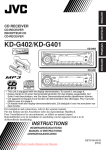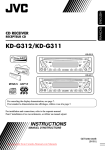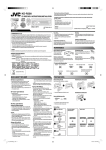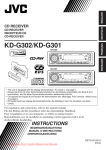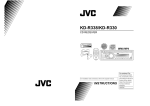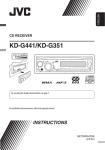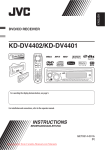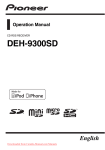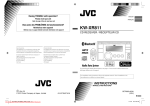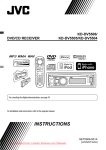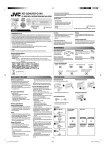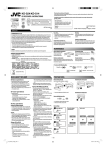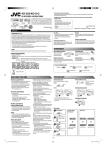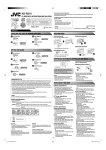Download JVC KD-R207EE User Guide Manual - CaRadio
Transcript
Thank you for purchasing a JVC product. Please read all instructions carefully before operation, to ensure your complete understanding and to obtain the best possible performance from the unit. KD-R207 CD RECEIVER: INSTRUCTIONS/INSTALLATION Installation/connection are explained at the last section of this manual (reverse page, indicated with symbol). 0808DTSMDTJEIN GET0591-001A EN © 2008 Victor Company of Japan, Limited [EE] ENGLISH IMPORTANT FOR LASER PRODUCTS MORE ABOUT THIS UNIT 1. CLASS 1 LASER PRODUCT 2. CAUTION: Do not open the top cover. There are no user serviceable parts inside the unit; leave all servicing to qualified service personnel. 3. CAUTION: Visible and/or invisible class 1M laser radiation when open. Do not view directly with optical instruments. 4. REPRODUCTION OF LABEL: CAUTION LABEL, PLACED OUTSIDE THE UNIT. Basic operations • By pressing SRC on the unit, you can also turn on the power. If the source is ready, playback also starts. • If you turn off the power while listening to a track, playback will start from where it had been stopped previously next time you turn on the power. Tuner operations [European Union only] For safety... Warning • Do not raise the volume level too much, as this will block outside sounds, making driving dangerous. • Stop the car before performing any complicated operations. If you need to operate the unit while driving, be sure to look around carefully or you may be involved in a traffic accident. Caution on volume setting Temperature inside the car... If you have parked the car for a long time in hot or cold weather, wait until the temperature in the car becomes normal before operating the unit. Discs produce very little noise compared with other sources. Lower the volume before playing a disc to avoid damaging the speakers by the sudden increase of the output level. • During SSM search... – All previously stored stations are erased and the stations are stored anew. – When SSM is over, the station stored in the lowest preset number will be automatically tuned in. • Network-Tracking Reception requires two types of Radio Data System signals—PI (Programme Identification) and AF (Alternative Frequency) to work correctly. • If a Traffic Announcement is received by TA Standby Reception, the volume level automatically changes to the preset level (TA VOL) if the current level is lower than the preset level. • When Alternative Frequency Reception is activated (with AF selected), Network-Tracking Reception is also activated automatically. On the other hand, NetworkTracking Reception cannot be deactivated without deactivating Alternative Frequency Reception. Disc operations PREPARATIONS Caution for DualDisc playback How to reset your unit Detaching the control panel Reset the unit after installation is complete. • The Non-DVD side of a “DualDisc” does not comply with the “Compact Disc Digital Audio” standard. Therefore, the use of Non-DVD side of a DualDisc on this product may not be recommended. General • This unit has been designed to reproduce CDs/CD Texts, and CD-Rs (Recordable)/CD-RWs (Rewritable) in audio CD (CD-DA) and MP3/WMA formats. • Your preset adjustments will also be erased. Attaching the control panel How to forcibly eject a disc • Be careful not to drop the disc when it ejects. • If this does not work, reset your unit. Playing a CD-R or CD-RW • Use only “finalized” CD-Rs or CD-RWs. • This unit can play back multi-session discs; however, unclosed sessions will be skipped while playing. • Some CD-Rs or CD-RWs may not be played back on this unit: – Discs are dirty or scratched. – Moisture condensation has occurred on the lens inside the unit. – The pickup lens inside the unit is dirty. – The files on the CD-R/CD-RW are written using the “Packet Write” method. – There are improper recording conditions (missing data, etc.) or media conditions (stained, scratched, warped, etc.). • CD-RWs may require a longer readout time since the reflectance of CD-RWs is lower than that of regular CDs. Playing an MP3/WMA disc • This unit can play back MP3/WMA files with the extension code <.mp3> or <.wma> (regardless of the letter case—upper/lower). • This unit can show the names of albums, artists (performer), and tag (Version 1.0, 1.1, 2.2, 2.3, or 2.4) for MP3 files and for WMA files • This unit can play back MP3/WMA files meeting the conditions below: – Bit rate: 8 kbps — 320 kbps – Sampling frequency: 48 kHz, 44.1 kHz, 32 kHz (for MPEG-1) 24 kHz, 22.05 kHz, 16 kHz (for MPEG-2) – Disc format: ISO 9660 Level 1/ Level 2, Romeo, Joliet, Windows long file name • The maximum number of characters for file/folder names vary depending on the disc format used (includes 4 extension characters—<.mp3> or <.wma>). – ISO 9660 Level 1: up to 12 characters; ISO 9660 Level 2: up to 31 characters; Romeo: up to 128 characters; Joliet: up to 64 characters; Windows long file name: up to 128 characters • This unit can recognize a total of 512 files, 255 folders, and 8 hierarchical levels. • This unit can play back files recorded in VBR (variable bit rate). Files recorded in VBR have a discrepancy in the elapsed time display, and do not show the actual elapsed time. In particular, this difference becomes noticeable after performing the search function. • This unit cannot play back the following files: – MP3 files encoded in: MP3i and MP3 PRO format, in an inappropriate format, layer 1/2. – WMA files: encoded in lossless, professional, and voice format; not based upon Windows Media® Audio; copyprotected with DRM. – Files which have data such as AIFF, ATRAC3, etc. • The search function works but search speed is not constant. Basic settings Enter PSM menu. Finish MAINTENANCE Select an item. Adjust. 1 Canceling the display demonstrations How to clean the connectors To keep discs clean Select “DEMO,” then “DEMO OFF.” 2 Setting the clock Select “CLOCK H” (hour), then adjust the hour. Select “CLOCK M” (minute), then adjust the minute. Select “24H/12H,” then “24H” (hour) or “12H” (hour). Wipe the connectors with a cotton swab or cloth moistened with alcohol. Wipe in a straight line from center of disc to edge. Do not use liquid cleaners, thinners, or benzene. Connectors Moisture condensation To play new discs Moisture may condense on the lens inside the unit. Eject the disc and leave the unit turned on for a few hours until the moisture has evaporated. Remove any rough areas from the inner and outer edges of the disc. Available characters on the display Available characters Display indications Do not use the following discs: Single CD (8 cm disc) Unusual shape Downloaded from Caradio-Manual.com Manuals 1– EN Warped disc Sticker and sticker residue C-thru Disc (semitransparent disc) Stick-on label Transparent or semi-transparent parts on its recording area Basic operations Radio operations Control panel Check the current clock time/other information. See also “CLK DISP“ of “General settings—PSM.” • Turn on the power. • Turn off the power [Hold]. • Attenuate the sound (if the power is on). Note: FM1 and FM2: 87.5 MHz – 108.0 MHz FM3: 65.00 MHz – 74.00 MHz Select preset station. Detach the panel. Display window Disc indicator Radio Data System indicators Disc information indicators Tr (track) indicator Source display Track number Folder number Volume level indicator Time countdown indicator Select the bands. Search for a station—Auto Search. Manual Search: Hold either one of the buttons until “M” flashes on the display, then press it repeatedly. • MO: Lights up in monaural mode. • ST: Lights up when receiving an FM stereo broadcast with sufficient signal strength. Playback mode / item indicator • • • • • Select “FM/AM.” Volume control. *You cannot select “CD” as the playback source if no disc is in the unit. Select the source. When an FM stereo broadcast is hard to receive Reception improves, but the stereo effect will be lost. • MO indicator lights up. To restore the stereo effect, repeat the same procedure. LOUD (loudness) indicator EQ (equalizer) indicator FM station automatic presetting—SSM (Strong-station Sequential Memory) You can preset 6 stations for each band. Main display (time, playback information) Sound mode indicator Manual presetting (FM/AM) Example: Storing the FM station of 92.5 MHz into preset number 4 of the FM1 band. Disc operations Eject disc. • “NO DISC” appears. Press SRC to listen to another playback source. FM Radio Data System operations Searching for your favourite FM Radio Data System programme • 4 [Press] [Hold] • 5/∞: /¢ Go to the previous or next track. Reverses or fast-forwards the track. Go to the previous or next folder (for MP3/WMA discs). You can tune in to a station broadcasting your favourite programme by searching for a PTY code. [Press] Select track (for CD) or folder* number (01 – 06). [Hold] Select track (for CD) or folder* number (07 – 12). * Folders are required to assigned with 2-digit numbers at the beginning. Storing your favourite programme type You can store six favourite programme types. Preset programme types in the number buttons (1 to 6): The last selected PTY code appears. Example: Storing “ROCK M” into preset number 4. Turn on the power. Select one of your favourite programme types or a PTY code. Insert disc. All tracks will be played repeatedly until you change the source or eject the disc. Select a PTY code. or Selecting the playback modes Changing the display information After pressing M MODE, press the following buttons to... : Plays the current track repeatedly. FLDR RPT * : Plays all tracks of the current folder repeatedly. RPT OFF : Cancels. If there is a station broadcasting a programme of the same PTY code as you have selected, that station is tuned in. TRK RPT FLDR RND * : Plays all tracks of the current folder, then the tracks of the next folder at random. ALL RND : Plays all tracks of the current disc at random. RND OFF : Cancels. * Only while playing an MP3 or a WMA disc. Skipping a track quickly during play • For MP3/WMA disc, you can skip a track within the same folder. Example: Select track 32 While playing an audio While playing an MP3 or CD or CD Text a WMA disc A = B = Disc title/ performer *1 = Track title *1 = (back to the beginning) A = B = Album name/ performer (folder name *2) = Track title (file name *2) = (back to the beginning) Standby receptions TA Standby Reception TA Standby Reception allows the unit to switch temporarily to Traffic Announcement (TA) from any source other than AM and FM3. A : The elapsed playing time with the current track number B : Clock with the current track number To activate/deactivate TA Standby Reception • If the TP indicator flashes, TA Standby Reception is not yet activated. *1 If the current disc is an audio CD, “NO NAME” appears. *2 If an MP3/WMA file does not have tags or “TAG DISP” is set to “TAG OFF,” folder name and file name appear. To activate the reception, tune in to another station providing Radio Data System signals required for TA Standby Reception. Prohibiting disc ejection You can lock a disc in the loading slot. To activate and select your favourite PTY code for PTY Standby Reception, see “General settings—PSM: PTY-STBY.” • If the PTY indicator flashes, PTY Standby Reception is not yet activated. To activate the reception, tune in to another station providing these signals. External component operations You can connect an external component to the AUX (auxiliary) input jack on the control panel. Turn on the connected component and start playing the source. PTY codes NEWS, AFFAIRS, INFO, SPORT, EDUCATE, DRAMA, CULTURE, SCIENCE, VARIED, POP M (music), ROCK M (music), EASY M (music), LIGHT M (music), CLASSICS, OTHER M (music), WEATHER, FINANCE, CHILDREN, SOCIAL, RELIGION, PHONE IN, TRAVEL, LEISURE, JAZZ, COUNTRY, NATION M (music), OLDIES, FOLK M (music), DOCUMENT Portable audio player, etc. Downloaded from Caradio-Manual.com Manuals Tracing the same programme — Network-Tracking Reception When driving in an area where FM reception is not sufficient enough, this unit automatically tunes in to another FM Radio Data System station of the same network, possibly broadcasting the same programme with stronger signals. To change the Network-Tracking Reception setting, see “General settings—PSM: AF-REG.” Programme A broadcasting on different frequency areas (01 – 05) PTY Standby Reception PTY Standby Reception allows the unit to switch temporarily to your favourite PTY programme from any source other than AM and FM3. To cancel the prohibition, repeat the same procedure. 3.5 mm stereo mini plug (not supplied) Finish. 2– EN Automatic station selection — Programme Search Usually when you press the number buttons, the preset station is tuned in. If the signals from the FM Radio Data System preset station are not sufficient for good reception, this unit, using the AF data, tunes in to another frequency broadcasting the same programme as the original preset station is broadcasting. See “General settings—PSM: P-SEARCH.” INSTRUCTIONS OPERATIONS BAS TRE LOUD 00 +03 +01 +04 +02 +02 00 +01 –02 +01 00 +03 –06 to +06 FAD *2 (fader) Adjust the front and rear speaker balance. R06 to F06 LOUD *1 (loudness) LOUD ON or Boost low and high frequencies to LOUD OFF produce a well-balanced sound at a low volume level. VOL (volume) Adjust the volume. 00 to 50 (or 00 to 30) *3 *1 When you adjust the bass, treble, or loudness, the adjustment you have made is stored for the currently selected sound mode including “USER.” *2 If you are using a two-speaker system, set the fader level to “00.” *3 Depending on the amplifier gain control setting—AMP GAIN. Adjusting the sound General TRE *1 (treble) Adjust the treble. BAL (balance) L06 to R06 Adjust the left and right speaker balance. OFF ON OFF OFF ON OFF BAS: Bass; TRE: Treble; LOUD: (loudness) –06 to +06 Disc playback Preset values Indication (For) USER (Flat sound) ROCK (Rock or disco music) CLASSIC (Classical music) POPS (Light music) HIP HOP (Funk or rap music) JAZZ (Jazz music) BAS *1 (bass) Adjust the bass. FM/AM Sound adjustments General settings—PSM Select an item. Indication Item ( : Initial) DEMO • DEMO ON • DEMO OFF CLK DISP *1 • ON • OFF Adjust. Finish. Setting : The display demonstration will be activated automatically if no operation is done for about 20 seconds. : Cancels. : The clock time is shown on the display at all times when the power is turned off. : Cancels; pressing DISP will show the clock time for about 5 seconds when the power is turned off. CLOCK H (Hour) 0 – 23 (1 – 12) : [Initial: 0 (0:00)] CLOCK M (Minute) 00 – 59 : [Initial: 00 (0:00)] 24H/12H • 24H • 12H : See “Basic settings.” CLK ADJ *2 • AUTO : The built-in clock is automatically adjusted using the CT (clock time) data in the Radio Data System signal. : Cancels. • OFF AF-REG *2 • AF • OFF : When the currently received signals become weak, the unit switches to another station (the programme may differ from the one currently received). • The AF indicator lights up. : When the currently received signals become weak, the unit switches to another station broadcasting the same programme. • The AF and REG indicators light up. : Cancels. PTY-STBY *2 OFF, PTY codes Activates PTY Standby Reception with one of the PTY codes. TA VOL * VOL 00 – VOL 50 (or [Initial: VOL 15] VOL 00 – VOL 30) *3 P-SEARCH *2 • ON • OFF : Activates Programme Search. : Cancels. DIMMER • ON • OFF : Dims the display and button illumination. : Cancels. TEL • MUTING 1/ MUTING 2 • OFF : Select either one which mutes the sounds while using a cellular phone. • ONCE • AUTO • OFF : : : • AUX ADJ A.ADJ 00 – A.ADJ 05 : Adjust the auxiliary input level to avoid the sudden increase of the output level when changing the source to external component connected to the AUX input jack on the control panel. TAG DISP • TAG ON • TAG OFF : Shows the tag while playing MP3/WMA tracks. : Cancels. AMP GAIN • LOW PWR : VOL 00 – VOL 30 (Select if the maximum power of each speaker is less than 45 W to prevent the speaker from being damaged.) : VOL 00 – VOL 50 • AF REG 2 SCROLL * 4 • HIGH PWR IF BAND • AUTO • WIDE MP3/WMA playback Enter PSM menu. Symptoms Remedies/Causes • Sound cannot be heard from the speakers. • Adjust the volume to the optimum level. • Check the cords and connections. • This unit does not work at all. Reset the unit. • SSM automatic presetting does not work. Store stations manually. • Static noise while listening to the radio. Connect the aerial firmly. • Disc cannot be played back. Insert the disc correctly. • CD-R/CD-RW cannot be played back. • Tracks on the CD-R/CD-RW cannot be skipped. • Insert a finalized CD-R/CD-RW. • Finalize the CD-R/CD-RW with the component which you used for recording. • Disc can be neither played back nor ejected. • Unlock the disc. • Eject the disc forcibly. • Disc sound is sometimes interrupted. • Stop playback while driving on rough roads. • Change the disc. • Check the cords and connections. • “NO DISC” appears on the display. Insert a playable disc into the loading slot. • “PLEASE” and “EJECT” appear alternately on the display. Press 0, then insert a disc correctly. • Disc cannot be played back. • Use a disc with MP3/WMA tracks recorded in a format compliant with ISO 9660 Level 1, Level 2, Romeo, or Joliet. • Add the extension code <.mp3> or <.wma> to the file names. • Noise is generated. Skip to another track or change the disc. (Do not add the extension code <.mp3> or <.wma> to non-MP3 or WMA tracks.) • A longer readout time is required Do not use too many hierarchical levels and folders. (“READING” keeps flashing on the display). • Tracks are not played back in the order you Playback order is determined when the files are recorded. have intended. • The elapsed playing time is not correct. This sometimes occurs during playback. This is caused by how the tracks are recorded on the disc. • The correct characters are not displayed (e.g. album name). This unit can only display letters (upper case), numbers, and a limited number of symbols. • Microsoft and Windows Media are either registered trademarks or trademarks of Microsoft Corporation in the United States and/or other countries. SPECIFICATIONS Audio amplifier section Maximum Power Output: Front/Rear: 45 W per channel Continuous Power Output (RMS): Front/Rear: 17 W per channel into 4 Ω, 40 Hz to 20 000 Hz at no more than 0.8% total harmonic distortion. Load Impedance: 4 Ω (4 Ω to 8 Ω allowance) Tone Control Range: Bass: ±12 dB at 100 Hz Treble: ±12 dB at 10 kHz Frequency Response: 40 Hz to 20 000 Hz Signal-to-Noise Ratio: 70 dB Other Terminal: AUX (auxiliary) input jack : Cancels. Scrolls the displayed information once. Repeats scrolling (at 5-second intervals). Cancels. Pressing DISP for more than one second can scroll the display regardless of the setting. : Increases the tuner selectivity to reduce interference noise between adjacent stations. (The stereo effect may be lost.) : Subject to the interference noise from adjacent stations, but the sound quality will not be degraded and the stereo effect will remain. *1 If the power supply is not interrupted by turning off the ignition key of your car, it is recommended that you select “OFF” to save the car’s battery. *2 Only for FM Radio Data System stations. *3 Depends on the amplifier gain control. *4 Some characters or symbols will not be shown correctly (or will be blanked) on the display. Downloaded from Caradio-Manual.com Manuals CD player section Type: Compact disc player Signal Detection System: Non-contact optical pickup (semiconductor laser) Number of channels: 2 channels (stereo) Frequency Response: 5 Hz to 20 000 Hz Dynamic Range: 93 dB Signal-to-Noise Ratio: 98 dB Wow and Flutter: Less than measurable limit MP3 Decoding Format: (MPEG1/2 Audio Layer 3) Max. Bit Rate: 320 kbps WMA (Windows Media® Audio) Decoding Format: Max. Bit Rate: 192 kbps General Tuner section Frequency Range: FM1/2: 87.5 MHz to 108.0 MHz FM3: 65.00 MHz to 74.00 MHz AM: MW: 522 kHz to 1 620 kHz LW: 144 kHz to 279 kHz [FM Tuner] Usable Sensitivity: 11.3 dBf (1.0 μV/75 Ω) 50 dB Quieting Sensitivity: 16.3 dBf (1.8 μV/75 Ω) Alternate Channel Selectivity (400 kHz): 65 dB Frequency Response: 40 Hz to 15 000 Hz Stereo Separation: 30 dB [MW Tuner] Sensitivity/Selectivity: 20 μV/35 dB [LW Tuner] Sensitivity: 50 μV 3– EN Power Requirement: Operating Voltage: DC 14.4 V (11 V to 16 V allowance) Grounding System: Negative ground Allowable Operating Temperature: 0°C to +40°C Dimensions (W × H × D): Installation Size (approx.): 182 mm × 52 mm × 160 mm Panel Size (approx.): 188 mm × 58 mm × 13 mm Mass (approx.): 1.3 kg (excluding accessories) Design and specifications are subject to change without notice. INSTRUCTIONS TROUBLESHOOTING SETTINGS INSTALLATION This unit is designed to operate on 12 V DC, NEGATIVE ground electrical systems. If your vehicle does not have this system, a voltage inverter is required, which can be purchased at JVC IN-CAR ENTERTAINMENT dealers. The following illustration shows a typical installation. If you have any questions or require information regarding installation kits, consult your JVC IN-CAR ENTERTAINMENT dealer or a company supplying kits. • If you are not sure how to install this unit correctly, have it installed by a qualified technician. In dash-mounting WARNINGS To prevent short circuits, we recommend that you disconnect the battery’s negative terminal and make all electrical connections before installing the unit. • Be sure to ground this unit to the car’s chassis again after installation. Notes: • Replace the fuse with one of the specified rating. If the fuse blows frequently, consult your JVC IN-CAR ENTERTAINMENT dealer. • It is recommended to connect to the speakers with maximum power of more than 45 W (both at the rear and at the front, with an impedance of 4 Ω to 8 Ω). If the maximum power is less than 45 W, change “AMP GAIN” setting to prevent the speakers from being damaged (see “General settings—PSM”). • To prevent short-circuit, cover the terminals of the UNUSED leads with insulating tape. • The heat sink becomes very hot after use. Be careful not to touch it when removing this unit. When you stand the unit, be careful not to damage the fuse on the rear. Do the required electrical connections. Heat sink Bend the appropriate tabs to hold the sleeve firmly in place. Parts list for installation and connection Removing the unit Before removing the unit, release the rear section. A/B C D Control panel/ Hard case Sleeve Trim plate E F G Power cord Washer (ø5) Lock nut (M5) I J Rubber cushion Handles H Mounting bolt (M4 × 5 mm ; M5 × 12.5 mm) When using the optional stay ELECTRICAL CONNECTIONS Fire wall Stay (option) Dashboard Typical connections Before connecting: Check the wiring in the vehicle carefully. Incorrect connection may cause serious damage to this unit. The leads of the power cord and those of the connector from the car body may be different in color. 1 Connect the colored leads of the power cord in the order specified in the illustration below. 2 Connect the aerial cord. 3 Finally connect the wiring harness to the unit. Note: If your vehicle does not have any accessory terminal, move the fuse from the fuse position 1 (initial position) to fuse position 2, and connect the red lead (A7) to the positive (+) battery terminal. • The yellow lead (A4) is not used in this case. Screw (option) Install the unit at an angle of less than 30˚. When installing the unit without using the sleeve In a Toyota car for example, first remove the car radio and install the unit in its place. * Not supplied for this unit. Flat type screws (M5 × 8 mm)* Bracket* 15 A fuse Fuse position 2 Flat type screws (M5 × 8 mm)* Fuse position 1 Aerial terminal Pocket Bracket* Rear ground terminal Ignition switch Black Connect only the front speakers if your speaker system is two-speaker system. White with black stripe Yellow *2 Front speaker (left) White PRECAUTIONS on power supply and speaker connections To the metallic body or chassis of the car To a live terminal in the fuse block connecting to the car battery (bypassing the ignition switch) (constant 12 V) Gray with black stripe Fuse block TROUBLESHOOTING • The fuse blows. * Are the red and black leads connected correctly? • Power cannot be turned on. Front speaker Gray * Is the yellow lead connected? (right) • No sound from the speakers. Blue with white Green with black stripe * Is the speaker output lead short-circuited? stripe To the remote lead of other equipment or • Sound is distorted. power aerial if any (200 mA max.) Rear speaker * Is the speaker output lead grounded? Green Brown (left) * Are the “–” terminals of L and R speakers grounded in common? To cellular phone system • Noise interfere with sounds. Purple with black stripe * Is the rear ground terminal connected to the car’s chassis using shorter and thicker cords? • This unit becomes hot. *1 Not supplied for this unit. Rear speaker Purple 2 Before checking the operation of this unit prior to installation, this * Is the speaker output lead grounded? * (right) * Are the “–” terminals of L and R speakers grounded in common? lead must be connected, otherwise the power cannot be turned on. • This unit does not work at all. * Have you reset your unit? Downloaded from Caradio-Manual.com Manuals 4 – EN Red To an accessory terminal in the fuse block INSTALLATION / CONNECTION PREPARATION






